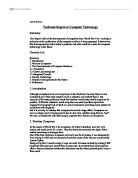Describe the Turing Test for deciding whether computers or machines can think? Is this an effective way of demonstrating machine intelligence? How close have machines got to this form of thinking in practice?
Describe the Turing Test for deciding whether computers or machines can think? Is this an effective way of demonstrating machine intelligence? How close have machines got to this form of thinking in practice?
"The question of whether a computer can think is no more interesting than the question of whether a submarine can swim"
The question of whether ‘can computers or machines think’ has long been an area which has been the centre of discussion with computing academics dating back to philosophers such as Plato, Aristotle and Descartes and “is in fact at the heart of the fertile intersection between philosophy, technology and computer science”. However the result of many of these discussions have produced further questions, such as, who knows, and what does it mean to think?
This attitude in essence forms the basis for the famous Turing Test, which was devised by the British mathematician and logician Alan Turing. In one of Turing’s papers “Computing machinery and intelligence”, he declared that if “a human judge engages in a natural language conversation with one human and one machine, each of which try to appear human; if the judge cannot reliably tell which is which, then the machine is said to pass the test”. The test was in fact invented after a party game called the “Imitation Game”, whereby a man and a woman would be situated in two separate rooms, and guests would aim at trying to differentiate between them by writing a series of questions and reading the answers which were sent back to them by a machine. Turing’s main aim in carrying out the test was to develop the question of ‘Can machines think?’ to anew one, which “drew a fairly sharp line between the physical and intellectual capacities of a man.”
What must be considered when attempting to answer this question is the major arguments that have been raised with regard to artificial intelligence, and Turing’s paper “Computing Machinery and Intelligence” consider nine common objections which include some of these arguments. This question it could be said involves us thinking for clear cut definitions, such as what is thought? A document which considers modern artificial intelligence claims that “every aspect of learning or any other feature of intelligence can in principle be so precisely described that a machine can be made to simulate it.” However this word ‘simulate’ appears to be quite important in the sense that humans “think” and computers “simulate thinking”. Turing claimed that, “if a machine can simulate thought to the point where it is indistinguishable from a human, then we should remove the quotes and grant that it really thinks”. However as many critics and academics have identified, this is not accurate. One could argue the test is anthropomorphic, as it only tests whether the “subject resembles a human being”. What it fails to do is test for intelligence under two circumstances, firstly the Turing Test examines many behaviours which may not consider as intelligent, such as “susceptibility to insults or the temptation to lie”. A machine may be able to carry out the tasks one asks of it thus being very intelligent, but may not have the social skills and ability to hold a conversation and converse exactly like a human. Secondly, the test “fails to capture the general properties of intelligence, such as the ability to solve difficult problems or come up with original insights”. In essence it could be said that if a computer or a machine has the ability to solve a challenging equation or problem that no other human could solve, then in principle it would fail the test.







